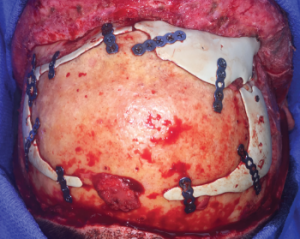Susan Bernstein is a freelance medical writer based in Georgia.
Explore This Issue
April 2019VSP and Custom Implants: Any Cons?

Custom implants secured.
Image courtesy of J. David Kriet, MD
Are there any potential pitfalls for VSP or 3D-printed implant customization that head and neck surgeons should know about? In a retrospective analysis of 54 virtually planned craniofacial surgeries performed from July 2012 to October 2016 at the University of Montreal Teaching Hospitals, researchers analyzed surgical errors. The study included 46 orthognathic surgeries and eight free bone transfers (Plast Reconstr Surg Glob Open. 2018;6:e1443).
While 85% of the orthognathic virtual surgical plans were completely adhered to by surgeons, 11% of the VSPs were partially adhered to and 4% of the VSPs were abandoned, they found. Reasons for partially or totally abandoning the plan included poor communication between surgeon and engineer, poor appreciation for condyle placement on preoperative scans, soft-tissue impedance to bony movement, rapid tumor progression, and poor preoperative assessment of anatomy.
The study’s authors concluded that while VSP is a useful tool for craniofacial surgery, improving outcomes and decreasing operative time, surgeons must be aware of potential pitfalls. They called for more surgical training and experience with these technologies.